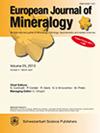用平衡和动力学方法了解罕见的绿绿石+黑云母组合的产状
IF 1.7
3区 地球科学
Q2 MINERALOGY
引用次数: 2
摘要
摘要氯云母和黑云母在中压Barroviinterranes中共存的情况非常罕见,控制它们平衡关系的参数仍然存在争议。各种研究已经研究了压力(P)、温度(T)、大块岩石(X大块)和流体(X流体)成分对该组合稳定性的影响。在这里,我们对小喜马拉雅序列(尼泊尔-喜马拉雅东部)上部的角闪岩相变质精英进行了热力学建模,这些参数主要影响绿柱石的稳定性 + 黑云母组合。在MnNKCFMASHTO系统中计算的P–T等化学相图未能再现类氯云母和黑云母的共存,预测黑云母在比类氯云母分解更高的温度下出现。无论是流体成分(即由于CO2的存在而降低的H2O活性)还是系统的氧化程度更高的状态都不利于它们的共存,而H2O稍不饱和的条件会使黑云母的稳定性场朝着较低的温度扩展,从而允许氯云母的发展 + 黑云母组合。动力学因素可能进一步促进了该组合的稳定性:由于十字石成核的困难和/或十字石溶解的缓慢,消耗和产生十字石反应的热超越可能增强了十字石在与黑云母存在相容的温度下的介稳持久性。由于动力学效率与流体可用性程度有内在联系,这两个因素(即H2O-不饱和条件和类氯消耗的动力学)可能是互补的,而不是相互排斥的。本文章由计算机程序翻译,如有差异,请以英文原文为准。
Equilibrium and kinetic approaches to understand the occurrence of the uncommon chloritoid + biotite assemblage
Abstract. The coexistence of chloritoid and biotite in medium-pressure Barrovian
terranes is quite uncommon, and the parameters controlling their equilibrium
relations are still controversial. Various studies have already investigated
the influence of pressure (P), temperature (T), bulk rock (X bulk) and fluid
(X fluid) compositions on the stability of this assemblage. Here we apply
forward thermodynamic modelling on amphibolite-facies metapelites from the
upper portion of the Lesser Himalayan Sequence (eastern Nepal Himalaya) to
test which parameters mostly influence the stability of the chloritoid + biotite assemblage. P–T isochemical phase diagrams calculated in the
MnNKCFMASHTO system fail in reproducing the coexistence of chloritoid and
biotite, predicting biotite appearance at higher temperatures than
chloritoid breakdown. Neither the fluid composition (i.e. reduced H2O
activity due to the presence of CO2) nor a more oxidated state of the
system favours their coexistence, while slightly H2O-undersaturated
conditions expand the biotite stability field toward lower temperatures,
allowing the development of the chloritoid + biotite assemblage. Kinetic
factors could have further contributed to the stability of this assemblage:
thermal overstepping of the chloritoid-consuming and staurolite-producing
reaction, induced by the difficulty in the staurolite nucleation and/or by
the sluggishness of chloritoid dissolution, could have enhanced the
metastable persistence of chloritoid at temperatures compatible with the
presence of biotite. Being the kinetics efficiency intrinsically linked to
the degree of fluid availability, the two factors (i.e.
H2O-undersaturated conditions and kinetics of the chloritoid-consuming
reaction) were likely complementary rather than mutually exclusive.
求助全文
通过发布文献求助,成功后即可免费获取论文全文。
去求助
来源期刊
CiteScore
2.80
自引率
9.50%
发文量
40
审稿时长
6-12 weeks
期刊介绍:
EJM was founded to reach a large audience on an international scale and also for achieving closer cooperation of European countries in the publication of scientific results. The founding societies have set themselves the task of publishing a journal of the highest standard open to all scientists performing mineralogical research in the widest sense of the term, all over the world. Contributions will therefore be published primarily in English.
EJM publishes original papers, review articles and letters dealing with the mineralogical sciences s.l., primarily mineralogy, petrology, geochemistry, crystallography and ore deposits, but also biomineralogy, environmental, applied and technical mineralogy. Nevertheless, papers in any related field, including cultural heritage, will be considered.

 求助内容:
求助内容: 应助结果提醒方式:
应助结果提醒方式:


